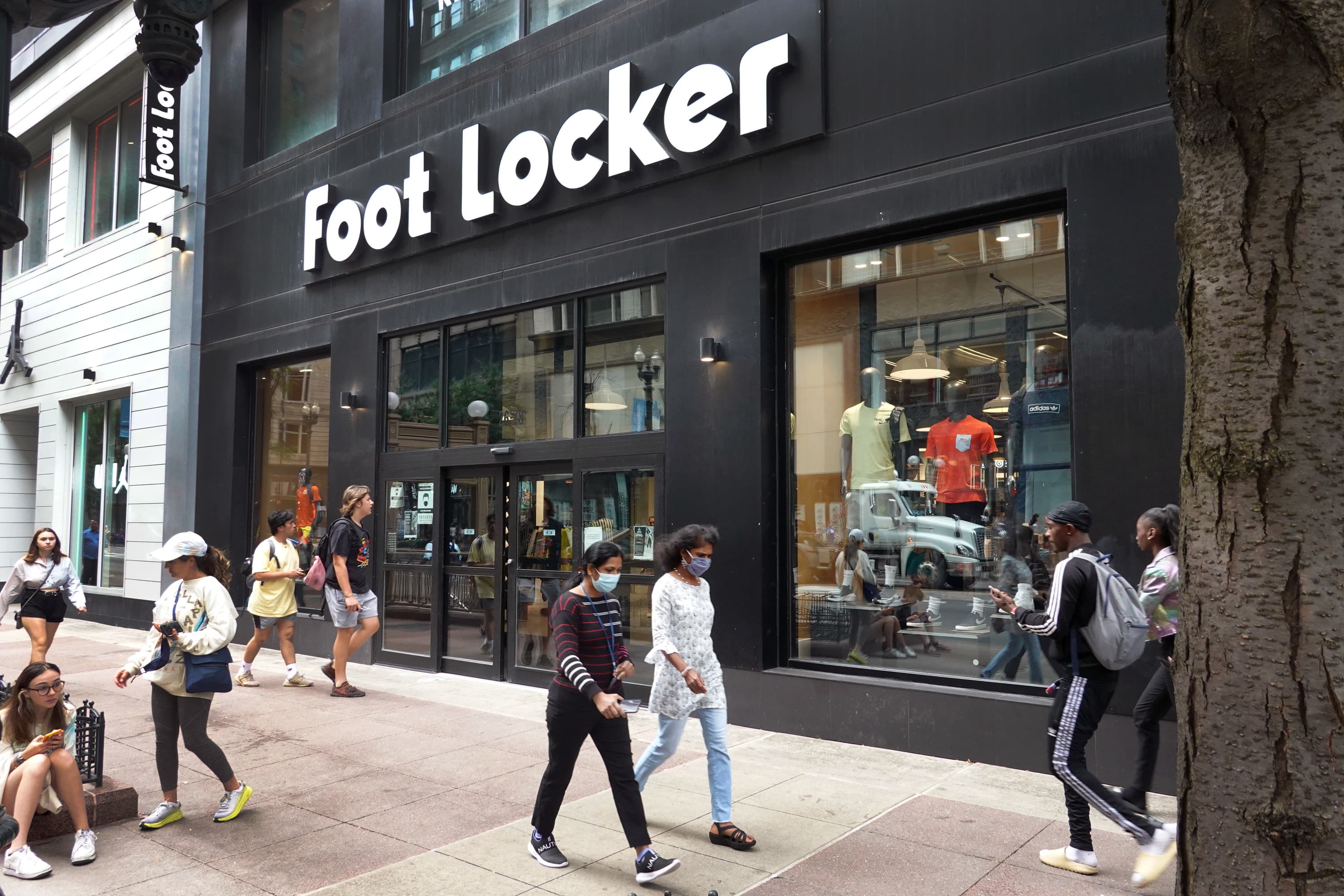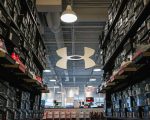
A sign hangs above the entrance of a Foot Locker store on August 02, 2021 in Chicago, Illinois.
Scott Olson | Getty Images
Foot Locker’s stock plummeted more than 27% Friday after a worse-than-expected consumer slowdown led to a double-digit sales drop, prompting the company to slash its outlook just two months after introducing it.
Following a string of better-than-expected earnings from major retailers like Target, TJ Maxx and Walmart this week, Foot Locker’s poor report could signal trouble ahead for other names in the sector, as a range of companies announce earnings over the next few weeks.
related investing news
Foot locker missed on both the top and bottom lines and said it had to aggressively promote merchandise to clear steep inventory levels and convince shoppers to use their discretionary dollars on shoes and clothes.
Here’s how the athletic apparel retailer did in its first fiscal quarter compared with what Wall Street was anticipating, based on a survey of analysts by Refinitiv:
- Earnings per share: 70 cents adjusted vs. 81 cents expected
- Revenue: $1.93 billion vs. $1.99 billion expected
The company’s reported net income for the three-month period that ended April 29 was $36 million, or 38 cents a share, compared with roughly $132 million, or $1.37 per share, a year earlier.
Sales dropped to $1.93 billion, down 11.4% from $2.18 billion a year earlier.
Shares closed 27% lower Friday, giving the company a market cap of $2.82 billion.
Foot Locker now expects sales to be down 6.5% to 8% for the year, compared with a prior range of down 3.5% to 5.5%. It expects comparable sales to fall 7.5% to 9%, compared with a prior range of down 3.5% to 5.5%.
Foot Locker expects non-GAAP earnings per share to be between $2 and $2.25, compared to its previous outlook of $3.35 to $3.65.
The company anticipates gross margins will be between 28.6% to 28.8%, compared with a prior range of 30.8% to 31%.
“Consumer demand, you know, has softened since investor day [earlier this year] and you know, signals are that we think that pressure will continue,” CEO Mary Dillon said during an analyst call. “As we came into this year, though, we knew there was some pressure because of the lower tax refund. We had hoped that things would snap back post that and what we saw is that it really hasn’t to the extent that we were forecasting or hoping for.”
The company’s shoppers, which skew middle to lower income, face pressure on discretionary spending from persistent inflation in household necessities like gas, rent and groceries, Dillon said. She added that the company has seen “an increase in usage of credit,” as consumer debt reaches a new high in the U.S.
During back to school and holiday, Foot Locker shoppers “rallied” but also became accustomed to higher-than-usual promotions, the company said. Shoppers were “resistant” to full prices come February and combined with macroeconomic factors, it created “headwinds” for the company’s key running brands, said Frank Bracken, Foot Locker’s chief commercial officer and executive vice president.
Foot Locker’s poor report could be a harbinger of what’s to come, especially as retailers like Kohl’s, American Eagle, Abercrombie & Fitch, Ralph Lauren and Gap get ready to report earnings next week.
While key retailers posted better-than-expected earnings this week, 45% of the sector has yet to report, the Bank of America trading desk noted. The companies still to come aren’t as high quality as the ones that reported this week, the bank said.
“I think FL commentary punishes the sector today and adds to folks’ pre-existing nervousness re: the results still to come over the next few weeks,” the trading desk told clients.
Foot Locker began aggressively promoting merchandise in April to drive sales but the heavy discounting – combined with an uptick in retail theft – shaved four percentage points off of its margins in the first quarter compared to the prior-year period. The company expects promotions will pressure margins moving forward.
Other soft-line retailers, or those that sell soft goods like apparel and shoes, could also report a margin squeeze in the coming weeks due to an uptick in promotions across the sector to cater to price-conscious consumers, analysts told CNBC previously.
Nike ‘reset’ contributes to slow sales
The earnings come eight months into Dillon’s tenure with Foot Locker and just two months after she unveiled the company’s new strategy at an upbeat investor day in March.
Dillon touted the company’s “renewed” partnership with Nike – it’s most prominent and largest vendor – and said she had spent a “great deal of time … revitalizing” Foot Locker’s relationship with the sneaker giant since taking over.
During the investor day, the company said Nike will continue to lead its brand portfolio, accounting for 55% to 60% of its mix. But on Friday, it said its “reset” with the business contributed to slow comparable sales. It also noted a “constrained supply” of Nike products, which have long been one of its biggest sales drivers.
“The mix outside of Nike was 35% this quarter, that was up a couple of points so we do feel like we are making progress and diversifying the brand portfolio,” said Robert Higginbotham, the company’s outgoing chief financial officer and senior vice president of investor relations. “We haven’t given targets for the Nike or vendor mix penetration by year. We still very much expect to, over time, by 2026, reach over 40% in our mix with other vendors.”
While Nike has long been a crucial part of Foot Locker’s business, at times accounting for the majority of its sales, the sneaker giant is in the process of its own internal reset. It has forced Foot Locker to become less reliant on it.
Nike has called out Foot Locker as an important partner, but it has also spent the last several years boosting its direct-to-consumer business and cutting ties with wholesalers. Over the last several quarters, its wholesale revenues were up, but that was largely because Nike was leaning on those partners to clear out excess inventory.
During an earnings call in March, the company said it expects wholesale revenue to “moderate” for the next few quarters, which could signal even more trouble for Foot Locker ahead.








